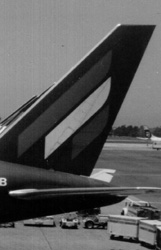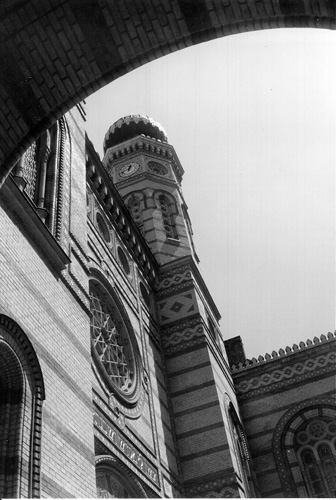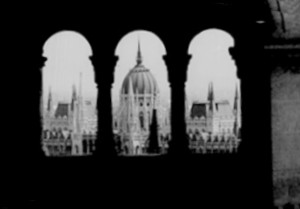By
Donald H. Harrison
Budapest (Special) -- The Hungarian airline which in the 1980s airlifted
many refugees from the Soviet Union
to Budapest and then on to freedom in Israel
is hoping that it can also make the Hungarian capital a stop-over for Israel-bound
American tourists.
 |
On Tuesday, June 2, Malev Airline inaugurated a non-stop
charter flight which covers the distance between Los
Angeles and Budapest in just 12 hours. A total of eight such flights
were planned during the summer--leaving Los Angeles every other Tuesday--to
test the strength of the West Coast market. There are about 50,000
Hungarian-Americans living in the greater Los Angeles area, and perhaps
200,000 throughout California.
Hungarian-Americans may not, themselves, fly to their ancestral land
in sufficient numbers to justify scheduling one of the planes of Malev's
relatively small fleet on a west coast run, but Adrian Rops, the airline's
west coast representative, says he has high hopes that the American Jewish
community will also be interested in Budapest as a destination--if not
for their entire vacations, then perhaps in combination with a stay in
Israel, to which Malev also flies. |
| Malev at LA International |
Even after the Holocaust, Budapest is a city with an estimated 100,000
Jews. The city's Dohany
Synagogue, capable of seating more than 3,000 people, is said to be
smaller than only Temple Emanu-El of New York. The city also is home to
numerous other synagogues, Jewish high schools and day schools, a Jewish
Community Center, a rabbinical seminary and a school for Jewish teachers,
among other institutions.
 |
Another point of interest for Jewish tourists are the ruins
of a medieval synagogue that was burned down sometime in the 17th century,
perhaps during the war in which control of this country was wrested from
the Ottoman Turks by the Austro-Hungarian Empire.
There also is a Jewish Museum which has among its artifacts head stones
showing that Jewish inhabitants were buried in Hungary in the third century
CE, when the country was the Roman colony of Pannonia. The headstones show
that Jews were living in Hungary even longer than the Magyar people which
gave the country its name. A marker near the entrance of the museum notes
that Theodor Herzl, founder of modern Zionism, was born in a
house that once stood at the same site. |
|
Dohany Synagogue |
Other interesting places for Jewish tourists to see are the "safe houses"
in which "protected Jews" given identity papers by diplomats from Sweden,
Switzerland and other neutral countries of World War II, were shielded
from deportation to death camps by the nazi occupation force. There are
also monuments to Raoul Wallenberg and other Righteous Gentiles who risked
their lives to protect Budapest's Jews from deportation to the death camps,
as well as ominous markers at various sites where the nazis conducted their
reign of terror.
Of course, there are all the general attractions of Budapest, including
the ubiquitous tour boats on the north-south flowing Danube River which
divides the city into the more residential Buda, on the hilly west side,
and the more commercial area of Pest, on the east. Once Buda and Pest were
separate and hostile cities, with the Danube serving as a border between
rival medieval empires.
 |
Today, the river of many beautiful bridges is crossed practically
every minute by streetcars and buses, for which inexpensive multiple day
passes may be purchased. Among favorite places to visit are the Castle,
overlooking the Danube, which once housed Habsburg queens and kings but
which now has been converted into an art musuem with a princely collection
of Hungarian artists; the nearby Fisherman's Bastion from which one can
see across the river to Budapest's ornate Parliament Building; and the
many museums located on both sides of the river. |
| Parliament
as seen from Fisherman's Bastion |
Visitors will note many signs of the good relations between Israel and
Hungary. Israel's flag is reproduced with the flags of other nations on
ticket kiosks and sightseeing buses. At a few stops we heard a Hebrew speaking
guide telling a large group about the sites which were being described
to us in English. And, in the hotels, the accent with which you hear a
fellow guest speak English is almost as likely to be Israeli as it is to
be German or Russian.
Hungarian food runs to the heavy side, with beef stews, chicken paprikashes
and veals the most practical dishes for those who want to avoid ubiquitous
pork.
But the fast foods of "home" are never far away, with Burger King and
MacDonald's vying, it seems, for every prime corner of Budapest, and Wendy's,
Pizza Hut and Kentucky Colonel also showing their presence. Meanwhile,
Pepsi and Coke compete to install their logos in as many restaurants as
possible. Additionally, we found kosher restaurants in the "Jewish quarter"
near the large Dohany synagogue, but were unimpressed by the ambience and
the fare.
We were pleased with our flights between Hungary and the United States.
Malev's service is well-paced, with beverages served shortly after takeoff,
followed by meal service, then a presentation of short video subjects about
life and places to see in Hungary. This proved a valuable introduction
to our destination, and is a program which other airlines might well consider
imitating.
The ever-cheerful flight attendants distributed a nice selection of
newspapers--including an English language Hungarian newspaper--and seemed
pleased to answer our questions about their country.
During the 12-hour flight between Los Angeles and Budapest, there were
also two in-flight movies shown, which passengers could listen to on earphones
in either English or Hungarian.
The airline also stocks Tokaj wines and Unicum liquer to give
travellers a foretaste or remembrance of Hungarian specialties. Breakfasts
and dinners were typically Hungarian fare, while the special kosher meals,
which may be ordered in advance, were packaged with great care. I was told,
with some pride, that "Malev uses the same kosher caterers as El Al, and
what better recommendation is there than that?"
|

